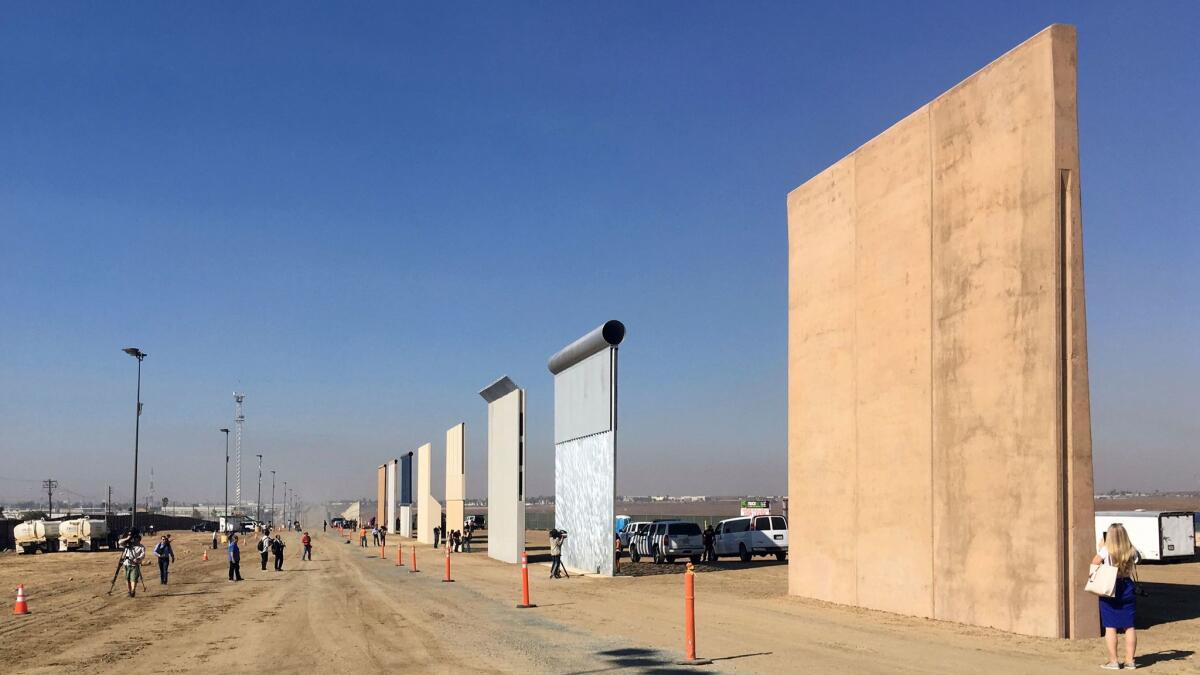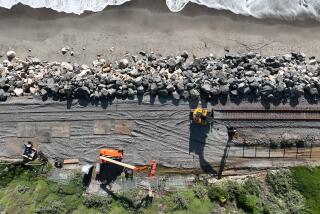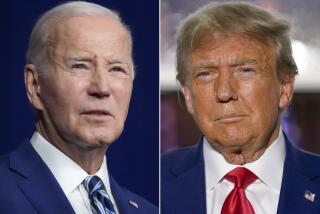Trump’s border wall prototypes are done. Will the president pick a winner?

The first stage of President Trump’s controversial border wall project ended this week, while the prospects for further construction — and even what type of permanent wall — remain uncertain.
Ron Vitiello, acting deputy commissioner for Customs and Border Protection, said Thursday during a news briefing that the monthlong construction of eight prototypes along a section of Otay Mesa in southern San Diego County was complete. The announcement was made in the shadow — literally — of one of the structures.
With the 30-foot prototypes looming behind and beside him, Vitiello said the walls now will undergo a period of testing to determine how effective the designs are.
The agency then expects to come up with a master design for a new wall, one that draws on what works and what doesn’t in the prototypes.
That design would be for both the primary wall along the Mexico border and a secondary wall set several hundred feet north.
“We are going to look at everything that is reflected here,” Vitiello said, referring to the eight wall models, “and then put out a new design standard for the immediate border barrier and the secondary barrier.”
Each of the walls will be tested to see how well they deter climbing, tunneling and tampering by tools and machines. The tests and subsequent evaluations will begin a month from now and take one to two months to complete, he said.
The anti-climbing and tunneling tests will be conducted on the walls built on Otay Mesa, Vitiello said. The test to withstand breaching will be made on a set of mock-ups — smaller versions of each wall — at an undisclosed location in San Diego.
The prototypes were built by six companies that won a national competition. Instead of picking a winning design from the group, as initially thought, it now appears concepts of one or more walls will be combined into a new design.
The future of any wall building still remains in doubt, though. While Customs had $20 million for the prototype project, the cost of building a wall across the border — or even large portions of it — is estimated to be in the tens of billions of dollars.
Congress is deadlocked on funding, with Democrats and many Republicans from border states opposing the project.
Since Jan. 25, when a Trump executive order called for construction of the wall along the southwestern U.S. border, officials have downplayed the idea of building across every mile of the border, which is marked by varied terrain, often rugged and rarely trafficked. Trump himself said the wall had to be “see-through,” and some Border Patrol officials indicated a preference for transparent designs so they can better observe the other side.
Vitiello declined to speculate about costs but said the need for the wall was real. “I’m no expert on price,” he said. “We think this works. We think it is valuable to do. We think it’s important.”
The walls erected on a dusty piece of Otay Mesa include four fashioned from concrete and four from other materials. Two are see-though — with bollard-type posts on the bottom section topped by a solid portion.
Five of the walls have some kind of structure on top that appears to impede climbing or grappling. One is topped by barbed wire, while others have rounded steel fixtures on top.
All are sunk at least six feet into the ground to deter tunneling. Vitiello said the designs also call for underground sensor cables.
There has been speculation since the project began Sept. 26 that Trump would visit the site. Vitiello demurred when asked whether the president would come. “I’m not in charge of the president’s schedule,” he said. He also did not say whether Trump would pick the design winner, something the president previously has said.
The project has become a draw for journalists and politicians, both domestically and internationally. News crews from Germany, Korea and elsewhere have descended on the mesa, shuttled to the building site two or three times a day by Border Patrol agents.
“There is worldwide interest in this,” Customs spokesman Carlos Diaz said.
There also was interest just a stone’s throw from the walls in Mexico. As Vitiello got a briefing on each of the walls before the news conference, a group of half a dozen Mexican federal police watched, looking over the primary fence made of old Navy landing mats.
Two Border Patrol agents standing in the bed of a pickup backed up to the fence on the U.S. side chatted amiably with the federales. At one point, Vitiello hopped into the truck and also spoke with the Mexican police.
Later he said he thanked them for helping with security on their side of the border. “We’re grateful for their help in making sure this project went off in a safe manner,” he said.
It’s unclear what will happen to the constructed prototypes, each of which was built for between $300,000 and $500,000.
“We’re going to see what happens on the evaluations, and then we’ll make a plan to use them to the best of their ability,” Vitiello said. “We’re not sure whether they stay here, whether they are part of the infrastructure system. That will be determined through the testing and evaluation phase.”
Moran writes for the San Diego Union-Tribune.
More to Read
Start your day right
Sign up for Essential California for news, features and recommendations from the L.A. Times and beyond in your inbox six days a week.
You may occasionally receive promotional content from the Los Angeles Times.






